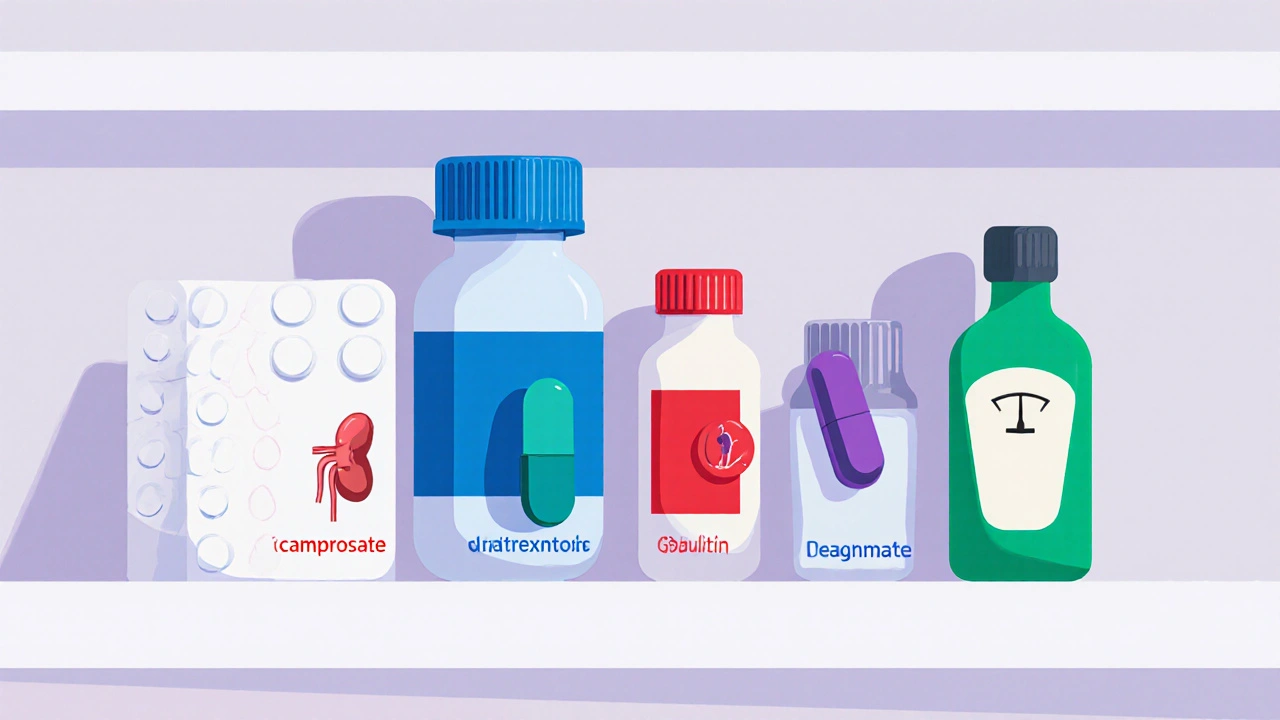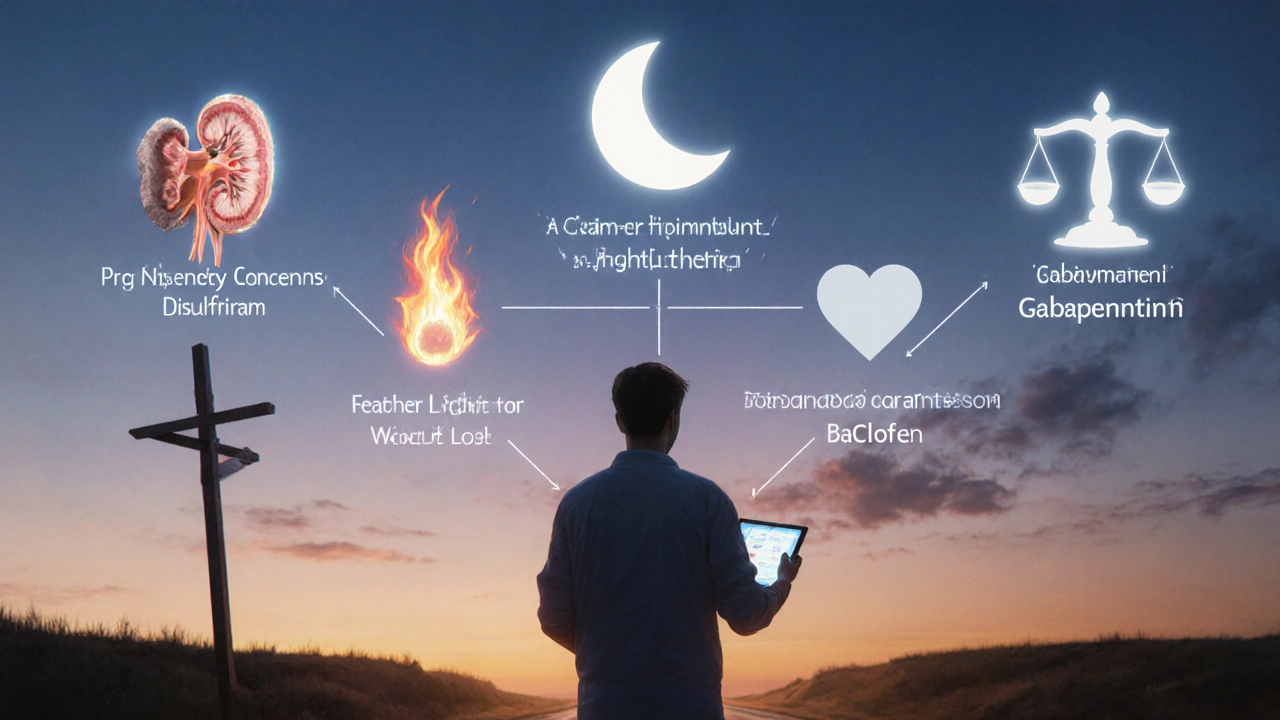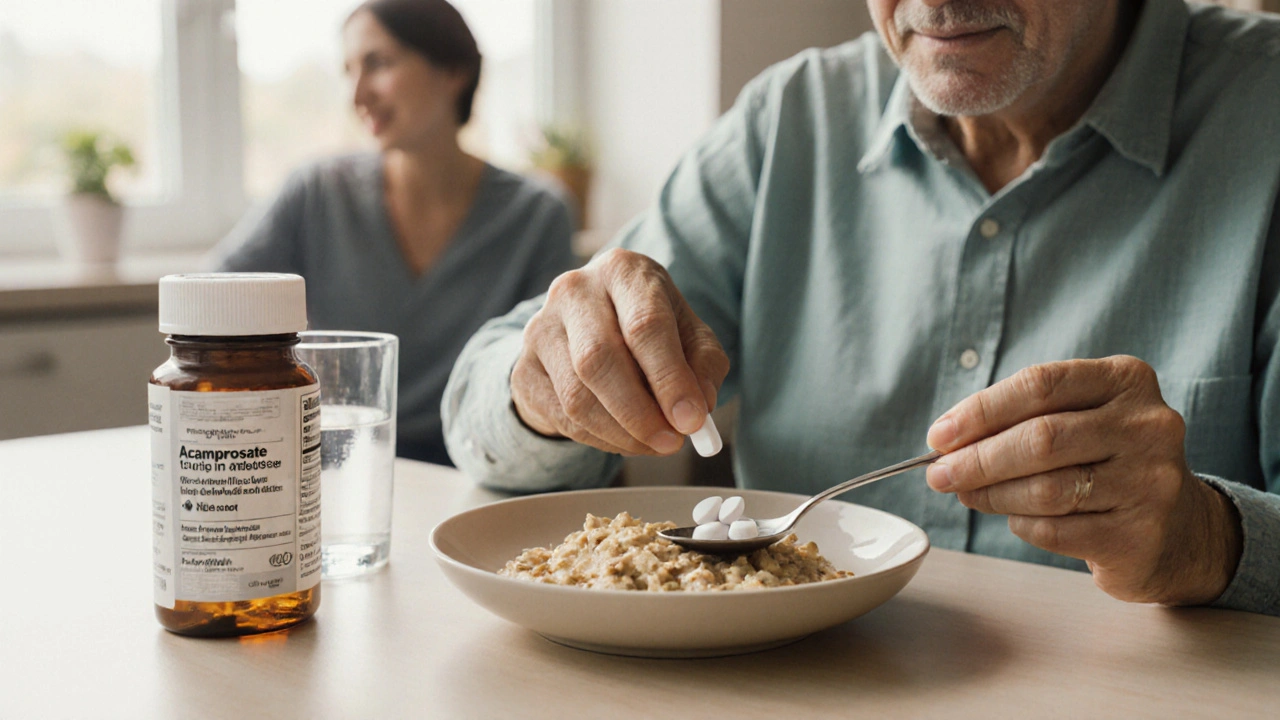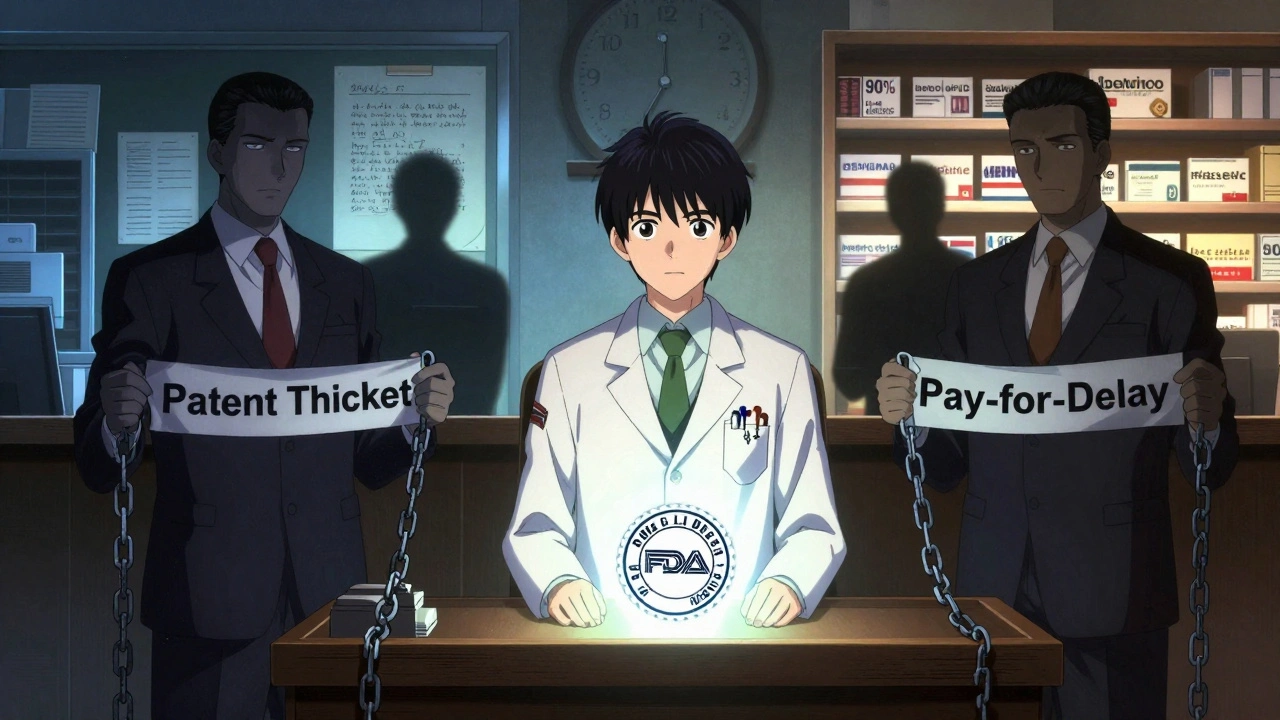Trying to quit drinking? You’ve probably heard of acamprosate, but you might wonder if it’s the right choice or if other medicines could work better. Below we break down how acamprosate stacks up against the most common alternatives and give you a clear picture of when each one shines.
What is Acamprosate?
Acamprosate is a synthetic salt that helps maintain abstinence in people with alcohol use disorder (AUD) by modulating the brain’s glutamate system. It was approved by the Food and Drug Administration (FDA) in 2004 and is listed in the World Health Organization (WHO) essential medicines list. The typical dose is 666mg three times a day, taken with meals, and it works best when combined with psychosocial support.
Acamprosate’s main advantage is its safety profile: it does not affect liver enzymes, making it a viable option for patients with mild‑to‑moderate liver disease. However, it must be taken consistently; missing doses reduces its effectiveness quickly.
Common Alternatives to Acamprosate
Naltrexone is an opioid‑receptor antagonist that blocks the rewarding effects of alcohol, reducing cravings and the likelihood of a relapse. It comes in a daily oral tablet (50mg) or a once‑monthly injectable (380mg). The medication is approved by the FDA and WHO for AUD and is especially helpful for people who report strong urges to drink.
Disulfiram works by inhibiting aldehyde dehydrogenase, causing an intense flushing reaction if alcohol is consumed. The reaction includes rapid heart rate, nausea, and vomiting, which serves as a strong deterrent. It is taken as a 250mg tablet once daily. Because the reaction can be severe, disulfiram is best suited for highly motivated patients who understand the risks.
Gabapentin is an anticonvulsant that off‑label reduces alcohol cravings and improves sleep quality. Typical dosing for AUD ranges from 300mg three times daily up to 1200mg three times daily, adjusted for renal function. Its side‑effect profile includes dizziness and mild weight gain.
Topiramate is another anticonvulsant that modulates GABA and glutamate pathways, helping to curb binge drinking. Doses start at 25mg nightly and can be titrated up to 200mg per day. Common side effects are cognitive slowing, paresthesia, and decreased appetite.
Baclofen is a muscle‑relaxant that targets GABA‑B receptors, reducing cravings in some patients. It is usually started at 5mg three times a day and increased to 30mg three times a day as tolerated. Sedation and low‑blood‑pressure episodes are the most frequent adverse events.
How the Medications Compare
| Medication | Primary Mechanism | Typical Dose | Abstinence Rate* (≈) | Common Side Effects | Major Contraindications | Approx. Monthly Cost (GBP) |
|---|---|---|---|---|---|---|
| Acamprosate | Modulates glutamate‑NMDA activity | 666mg PO TID | 35‑45% | Diarrhea, nausea, insomnia | Severe renal impairment (eGFR <30mL/min) | £70‑£90 |
| Naltrexone | Opioid‑receptor antagonism | 50mg PO daily OR 380mg IM monthly | 40‑55% | Nausea, headache, fatigue | Acute hepatitis, opioid dependence | £50‑£80 (tablet) / £150 (monthly injection) |
| Disulfiram | Aldehyde‑dehydrogenase inhibition | 250mg PO daily | 30‑40% | Metallic taste, headache, skin rash | Cardiac disease, severe liver disease, pregnancy | £20‑£35 |
| Gabapentin | Calcium‑channel modulation | 300‑1200mg PO TID | 30‑45% | Dizziness, peripheral edema, weight gain | Severe renal impairment (dose‑adjust) | £45‑£70 |
| Topiramate | GABA potentiation & glutamate antagonism | 25‑200mg PO daily (titrated) | 35‑50% | Cognitive slowing, paresthesia, taste alteration | Kidney stones, glaucoma, pregnancy | £55‑£80 |
| Baclofen | GABA‑B receptor agonist | 5‑30mg PO TID | 30‑40% | Sedation, hypotension, dizziness | Severe renal or hepatic failure | £30‑£50 |
*Abstinence rates are drawn from meta‑analyses published between 2018 and 2024 and represent average outcomes after 12 months of treatment combined with counseling.

Choosing the Right Medication for Your Situation
- Kidney concerns: If you have reduced kidney function, acamprosate is usually avoided; naltrexone or an adjusted gabapentin dose may be safer.
- Strong cravings: Naltrexone’s opioid‑blocking effect tends to reduce intense cravings more effectively than acamprosate.
- Need for a deterrent: Disulfiram works best when you want a clear, immediate consequence for drinking.
- Sleep problems: Gabapentin often improves sleep quality, which can indirectly support sobriety.
- Weight loss goal: Topiramate may aid modest weight reduction, a side benefit for some patients.
- Pregnancy or planning: Most AUD medications are not recommended during pregnancy; the safest approach is behavioral therapy until after delivery.
- Cost sensitivity: Disulfiram and generic naltrexone tablets are the most affordable options, while monthly injectable naltrexone carries a higher price tag.
In practice, clinicians often combine medication with psychosocial interventions (cognitive‑behavioral therapy, twelve‑step groups, or digital recovery apps). The synergy between drugs and counseling is what drives the highest long‑term success rates.
Practical Considerations Before Starting
- Get a proper diagnosis of Alcohol Use Disorder from a qualified health professional.
- Discuss your medical history - liver disease, kidney function, heart health, current medications, and pregnancy status are all critical.
- Ask about monitoring: liver function tests for naltrexone, renal labs for acamprosate, and periodic blood pressure checks for baclofen.
- Check your insurance coverage. Many UK NHS formularies list naltrexone and acamprosate as first‑line; private prescriptions may be needed for gabapentin or topiramate.
- Plan for side‑effect management. For example, taking acamprosate with food reduces GI upset, while starting naltrexone at 25mg and titrating up can lessen nausea.
- Set realistic goals. Medication assists abstinence; it does not replace the need for lifestyle changes and support networks.

Pros and Cons at a Glance
| Medication | Pros | Cons |
|---|---|---|
| Acamprosate | Well‑tolerated, safe for liver disease, no opioid interaction | Three‑times‑daily dosing, less effective for strong cravings |
| Naltrexone | Reduces cravings, monthly injectable option, good for heavy drinkers | Cannot be used with opioids, may cause liver enzyme rise |
| Disulfiram | Powerful deterrent, inexpensive | Requires strict adherence, severe reaction if alcohol is consumed |
| Gabapentin | Improves sleep, helpful for anxiety‑related drinking | Drowsiness, dose adjustment for kidney disease |
| Topiramate | Can aid weight loss, strong effect on binge patterns | Cognitive side effects, not ideal for pregnant women |
| Baclofen | Low cost, oral dosing simple | Sedation, caution in cardiac patients |
Frequently Asked Questions
Can I take acamprosate and naltrexone together?
Yes, some clinicians prescribe both to cover craving reduction (naltrexone) and the post‑withdrawal stabilization (acamprosate). However, the combination increases pill burden, so the decision should be based on how severe your cravings are and your ability to stay adherent.
What if I have mild kidney disease?
Acamprosate is cleared by the kidneys, so it is usually avoided when eGFR is below 30mL/min. Naltrexone or a reduced‑dose gabapentin would be safer alternatives.
Is disulfiram still used in 2025?
Absolutely. Though its use has declined because of adherence challenges, it remains a low‑cost option for highly motivated patients who want a clear “red‑flag” if they drink.
Which medication works best for someone who drinks heavily on weekends?
Naltrexone, especially the monthly injectable form, is often preferred for binge‑type patterns because it bluntly reduces the rewarding feeling of a heavy episode. Topiramate can also be effective if weight loss is a secondary goal.
Can I use any of these drugs while pregnant?
Most AUD medications, including acamprosate, naltrexone, and disulfiram, are not recommended during pregnancy due to limited safety data. Behavioral therapy is the standard first‑line approach for pregnant patients.






Manno Colburn
October 12, 2025 AT 14:08Ever wondered why the brain seems to be a stubborn rebel when you try to quit the bottle?
The glutamate system, that silent architect of cravings, doesn't simply switch off because you take a pill.
The acamprosate, with its chemical name that sounds like a university lecture, attempts to calm the storm by nudging NMDA receptors back into a quiet hum.
But while the science sounds crisp, the daily ritual of three doses a day becomes a subtle tyranny over your schedule.
Missing one dose feels like pulling a loose thread from a sweater you’re trying to knit, and the whole thing unravels faster than you expect.
I once tried to align my medication times with my breakfast, lunch, and dinner, only to realize my irregular work shifts turned the regimen into a guessing game.
The side effects, a mild cascade of diarrhea and insomnia, remind you that even the 'safe' drugs have a price tag paid in discomfort.
And yet, for people with fragile livers, it is a lifesaver that doesn't add another load to the detox queue.
Philosophically, it raises the question: are we treating the disease or merely managing its shadows?
When you pair it with therapy, the synergy resembles a duet where one instrument tunes the other.
If you ignore the psychosocial support, the medication alone can feel like a lighthouse with a dead bulb.
In my own journey, the moments of clarity arrived not because the drug whispered, but because I stopped letting the cravings script my day.
I started keeping a journal, noting the exact hour I took each dose, the mood before, and the craving intensity after.
Over weeks, patterns emerged that no clinical trial could capture, like the way a rainy Tuesday softened my urge more than any tablet.
So, while acamprosate stands tall among the pharmacopeia, its true power is unlocked only when you respect the ritual it demands.
Treat it like a compass, not a magic wand, and you might just navigate the storm without losing yourself.
Namrata Thakur
October 16, 2025 AT 23:08Finding the right medicine is like picking the right teammate for a marathon-you need someone who matches your pace.
Acamprosate shines when you have a steady routine and want a gentle guard for your liver.
If cravings feel like a storm, naltrexone can be the umbrella that blocks the rain.
Remember, no pill works alone; counseling and a strong support network are the real win.
Stay hopeful, because each step forward, no matter how small, is progress.
Chloe Ingham
October 21, 2025 AT 08:08Do you ever feel the pharma giants are pulling strings behind the curtain of sobriety?
They push acamprosate as the ‘safe’ hero while hiding the truth about its modest success rates.
I suspect the real cure is being kept under lock and key, reserved for the elite.
Wake up, question the narrative, and don’t let them dictate your recovery.
Mildred Farfán
October 25, 2025 AT 17:08Oh sure, because a pill that costs a fortune and does nothing but remind you to take it three times a day is exactly what the universe promised.
But hey, at least it won’t mess with your liver-silver lining, right?
If you’re looking for a drama-free companion, maybe stick with water.
Danielle Flemming
October 30, 2025 AT 02:08Picture this: your brain is a chaotic orchestra, and each medication is a different instrument trying to find harmony.
Acamprosate plays the soft cello, soothing the glutamate strings, while naltrexone bangs the drums of opioid blockade.
Disulfiram? That's the blaring trumpet that screams if you even think about a sip.
Topiramate dances the delicate ballet of GABA and glutamate, and baclofen hums a low bass line.
Choosing the right tune depends on your personal rhythm, so spin the record and listen closely.
Anna Österlund
November 3, 2025 AT 11:08Don’t let anyone tell you acamprosate is a dead‑end; it works for a solid chunk of people!
If you’re tired of playing it safe, throw in naltrexone and watch the cravings melt!
Brian Lancaster-Mayzure
November 7, 2025 AT 20:08From my experience, consistency beats intensity when it comes to medication adherence.
Set alarms, link doses to meals, and you’ll build a habit that sticks.
Combine that with weekly check‑ins, and the progress becomes measurable.
Remember, the goal is sustainable abstinence, not a quick fix.
Erynn Rhode
November 12, 2025 AT 05:08While discussing pharmacological options, it’s crucial to differentiate between ‘efficacy’ and ‘effectiveness’, two terms that are often conflated.
Efficacy refers to the performance of a drug under ideal, controlled conditions, whereas effectiveness measures its real‑world impact.
Acamprosate’s reported abstinence rate of 35‑45 % reflects efficacy from clinical trials, not necessarily what every patient will experience.
Moreover, the side‑effect profile-diarrhea, nausea, insomnia-should be weighed against the patient’s comorbidities, especially renal function.
In short, a nuanced understanding of these concepts can guide personalized treatment decisions.
Jaylynn Bachant
November 16, 2025 AT 14:08The mind, like a river, flows around the rocks of addiction, and we try to dam it with meds.
Acamprosate attempts to smooth the current, but the river still finds a way to carve new paths.
Perhaps the true battle is not in the chemicals, but in the stories we tell ourselves about control.
If we change the narrative, the medication becomes a mere chapter, not the whole book.
Anuj Ariyo
November 20, 2025 AT 23:08Acamprosate, a glutamate modulator, offers a modest benefit, especially when paired with therapy, and it avoids liver toxicity, making it a viable choice for many.
Naltrexone, on the other hand, blocks opioid receptors, reduces cravings, and can be administered monthly, providing convenience, though it may affect liver enzymes.
Disulfiram, however, induces a severe reaction upon alcohol intake, which can be deterrent, yet it requires strict adherence, and the psychological impact can be significant.
Steve Kazandjian
November 25, 2025 AT 08:08I’m curious about how renal function limits acamprosate dosing.
If a patient has an eGFR of 40, do we halve the dose or stop altogether?
Also, what’s the typical timeframe before you see a drop in cravings?
Any practical tips from clinicians would be great.
Mike Rylance
November 29, 2025 AT 17:08Your commitment to recovery is commendable, and aligning medication with support services maximizes outcomes.
Let us collaborate to tailor a regimen that respects your health profile while fostering sustained abstinence.
Together, we can turn this journey into a success story.
Becky B
December 4, 2025 AT 02:08Don’t be fooled by the mainstream narrative that glorifies one‑size‑fits‑all solutions.
The pharmaceutical lobby pushes acamprosate as the ‘safe’ option, while quietly sidelining more potent alternatives.
If you’re ready to challenge the status quo, explore naltrexone or even off‑label gabapentin under proper supervision.
Your freedom to choose is a right, not a privilege granted by corporations.
Aman Vaid
December 8, 2025 AT 11:08The pharmacokinetics of acamprosate are linear, with a half‑life of approximately 20‑33 hours, leading to steady-state concentrations after 5–6 days of dosing.
Renal excretion accounts for 90 % of elimination, which is why eGFR below 30 mL/min/1.73 m² contraindicates its use.
Comparatively, naltrexone undergoes hepatic metabolism via glucuronidation, making it unsuitable for patients with significant liver impairment.
Thus, patient-specific organ function must guide medication selection.
xie teresa
December 12, 2025 AT 20:08I hear how overwhelming the choices can feel, especially when each option comes with its own set of pros and cons.
Take your time, discuss with your healthcare team, and trust that you’re making a thoughtful decision.
You deserve support every step of the way.